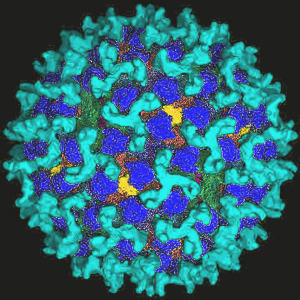Can we use models to predict virus outbreaks?
Posted on March 21, 2016 by Nancy Mendoza
Professor Matthew Baylis from the University of Liverpool will talk about his predictions for future impacts of climate change on infectious diseases of animals at the Microbiology Society Annual Conference today (21 March). If we can anticipate what will happen to our climate, we could accurately predict the next outbreak of bluetongue virus disease in the UK. Not only that, but Matthew says that it’s possible to use the same model to say how quickly and widely the virus could spread. Indeed, the model could be used to predict the threat from other viruses on the livestock industry, too.

By 2050 there will be nine billion people in the world, and ever greater numbers will get their dietary protein from animal sources. As a result, we need to increase livestock production and ensure its sustainability. Climate change raises a number of challenges to doing this, not least, as Matthew has demonstrated, the enhanced transmission of infectious diseases.
Vector-borne diseases – those that are transmitted by biting insects and ticks – are important emerging diseases of farm animals. Recently, Britain has seen two outbreaks of midge-borne viruses that have previously been absent from these shores, both of which severely impacted the livestock industry: bluetongue in 2008, and Schmallenberg in 2011. Vector-borne diseases have taken hold elsewhere, disproportionately affecting low-income countries and are considered to be endemic, acting as a reservoir for the rest of the world.
Climate change has had a number of impacts on the transmission of vector-borne viruses. More temperate climates have enabled some species of insects and ticks to widen their territories, making incursions to the more northerly areas of the world. Ambient temperature can have a very significant impact on the ability of a virus to replicate inside the insect – if it can’t replicate sufficiently, an insect bite is less likely to transmit virus to an animal. And the prevailing weather conditions will dictate the movement and survival of vectors, particularly flying insects such as midges and mosquitoes. In fact, midges carrying bluetongue virus, as well as those carrying Schmallenberg virus, blew across the English Channel to transmit disease from the continent to the east of England.
Matthew has developed a model that can predict an outbreak of vector-borne viral disease. It uses observed climate data across Europe and looks for correlation with disease outbreaks. The model was tested using the information about climate conditions in southern Europe over the few decades and it correctly predicts high risk of outbreaks, for example in 1987–1990, when there was an outbreak of African horse sickness in Spain. Knowing it works in retrospect means that it can be used to predict future disease outbreaks, based on climate forecasts.
Based on climate predictions, we can expect certain weather conditions at different times of the year. The more accurate our weather forecasts, the better we can tell the disease risk in a particular region. Matthew said: “At the moment the seasonal weather forecasts go to a maximum of three months, which is a bit frustrating. That said, if we can give three months’ notice of a bluetongue outbreak, that’s time to stockpile vaccine and have a plan to eradicate it quickly.”
So, how is climate change going to impact disease transmission? Matthew continued: “We’re already seeing the impact of climate change – the outbreak of bluetongue in 2006–7 was unprecedented and we can tie it to the prevailing climate at the time.
“With bluetongue, we were fortunate because it was a virus we already knew quite a lot about and the Meteorological Office was able to make predictions about where and when it might arrive. It was limited, though – we could only say in retrospect exactly where and when the conditions would have been right for an introduction, but that was useful as we at least knew where to look. That level of preparation is useful, as it allows for targeted surveillance or, in some settings, the strategic use of vaccines.
“The better we get at predicting what will happen to disease transmission as the climate changes, the more likely we are to be able to stamp out an outbreak before it takes hold.”
And that’s exactly what Matthew’s model can do. It can predict how rapid and widespread the transmission is likely to be, if and when the virus arrives.
Matthew and his colleagues also look at diseases that infect both animals and humans. They are already looking at Zika virus in light of the current outbreak in Brazil, which has been declared a public health emergency of international concern by the World Health Organization. This will include investigating the conditions required for the virus to replicate inside the mosquito vector, and how climate change affects the insect’s range and lifespan. Matthew said: “There is still a lot of work to do, but what we are really sure of is that climate change is contributing, along with other factors, to the emergence of livestock diseases.
“Many non-climate disease drivers are changing at the same time as climate and, when a disease emerges, it is usually difficult to attribute the emergence to climate change. This is particularly the case for human diseases, as our disease drivers are changing rapidly. The disease drivers of livestock are also changing, but less rapidly and livestock may act as sentinels of the effects of climate change on infectious diseases.”
Matthew says that in this way, animal viruses are acting as sentinels for the impact of climate change and it is certainly not too soon to act.
